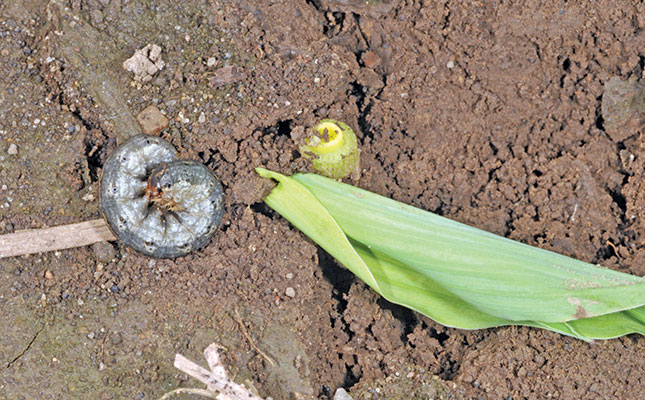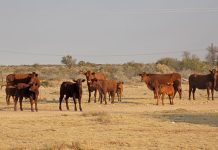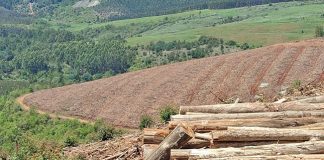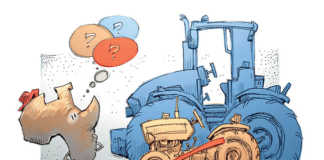
Photo: Prof Johnnie van den Berg
The larvae of the common cutworm (Agrotis segetum) are present throughout the year, overwintering in the soil and below weeds. They are usually a dark, dirty-grey or brown colour, and have a smooth, waxy appearance.
When disturbed, the larva coils up into a ‘C’ shape. It is usually found 20mm to 50mm below the surface near severed seedlings. It feeds mostly at night, and moults six times in all, growing larger with each instar.
A larva typically attacks the stems of maize seedlings, ‘cutting’ the plant down, hence the name of the pest.
Life cycle
Cutworm moths are nocturnal and take flight at night, laying eggs singly or in groups on the soil surface, or on the leaves of weeds and maize plants that may occur in lands in the few weeks prior to planting. The eggs are small, white and round.
When the eggs are laid during autumn and winter, various sizes of larvae will be found in the soil until spring.
Small larvae emerge from the eggs after about a week. Newly hatched larvae hide under, and feed on, the leaves of weeds or crops on and near the soil surface.
Very young larvae occur on top of the soil surface, below weed leaves, while larger larvae burrow into the soil and emerge only at night. After the sixth larval instar, the cutworm burrows deeper into the soil and make a small pupal chamber, from which the moth will emerge. Several overlapping generations may be present on a maize land.
Feeding habits
Cutworms emerge from the soil at night and move from plant to plant, severing the stems of seedlings at the soil surface. They may consume only a small portion of a plant before moving on to the next, causing serious damage in the process.
In older maize plants (four-leaf stage), the larva chews a neat, round hole into the stem just below ground level.
Cutworm damage is easily distinguished from damage caused by the black maize
beetle or false wireworm. In the case of the latter, the edges of the feeding holes have a frayed appearance.
Above-ground symptoms of cutworm damage include wilting of the central whorl leaf, followed by wilting of the entire plant.
In cases of severe cutworm infestation, entire rows of seedlings in a land can be destroyed by these voracious feeders. This could happen as early as four days after the first emergence of the seedlings.
Weed control
Weed control is of vital importance in the fight against the pest, and pre-planting weed management is crucial. Weed species with aerial parts covering an extended surface area create an ideal habitat for cutworm larvae and accommodate many more of the pests than small or spindly weeds.
Between 20 and 30 larvae per plant in the case of Senecio species (ragwort) and 77 larvae per plant with Conyza bonariensis (fleabane) have been reported.
Where practically possible, plough lands 35 days before planting and keep them free of weeds and volunteer plants until planting. This will starve to death any small cutworms that may already be present in the soil.
If you have planted a herbicide-tolerant maize variety, you may need to apply herbicide after seedling emergence to kill off weeds, as well as insecticide to control the cutworm.
Unfortunately, Bt maize, used for control of maize stem borers in South Africa, is ineffective against cutworm larvae. If you see cutworm damage after plant emergence, apply a registered insecticide to control the larvae.
Cutworm larvae remain below the surface when the soil is hot and dry. This inhibits the effectiveness of insecticides.
Insecticides should be applied when the soil is moist, as the larvae are more active above ground then. In addition, try to apply the insecticide during the afternoon; this reduces the degrading effects of heat and direct sunlight on the product, and ensures that the larvae, which are nocturnal, receive maximum exposure to it.
Predators
Cutworm eggs, larvae and pupae are preyed upon by a wide range of natural enemies before the larvae burrow into the soil. Wasps, ants and ground beetles play an invaluable role in controlling cutworm populations.
Although predation by these natural enemies is not always enough to prevent economic damage, these insects are of utmost importance in preventing more regular large-scale outbreaks.
Scouting remains one of the best weapons against cutworm. Inspect lands and the edges of bare areas for freshly severed plants, and search the top 5cm of soil around such plants for larvae. If you see any notched, wilted, dead or chopped weed or crop seedlings, dig around the roots of the plants for cutworms.
Email Prof Johnnie van den Berg at [email protected].












